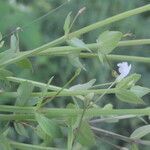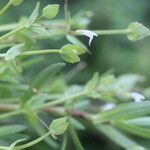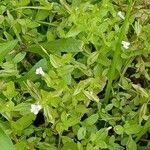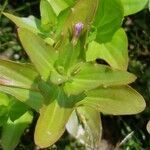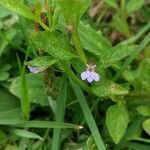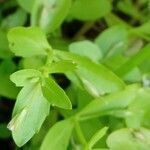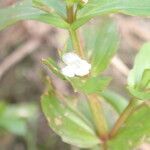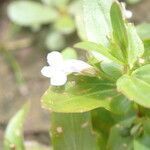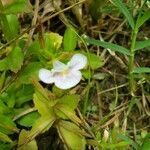Low, branching, glabrous or glandular annual 0.5–2(–3) dm; lvs entire or obscurely few-toothed; sep narrow, 3-nerved, 3–4.5 mm; cor 5–10 mm; later fls often cleistogamous; 2n=18, 32. Wet sandy or muddy shores; Que. and N.H. to N.D., s. to Fla. and Tex., and in the Pacific states. July–Sept. Two rather poorly defined vars., both widespread in our range. Var. dubia: Lvs to 3 cm, at least the lower ones narrowed to the base; pedicels relatively short, mostly 0.5–1.5 cm, surpassed by or only slightly surpassing their subtending lvs; seeds mostly 2–3 times as long as wide. (Ilysanthes d.; I. attenuata) Var. anagallidea (Michx.) Cooperr.: Lvs mostly 6–15 × 3–10 mm, all broadly rounded at base, or the lowermost ones a little narrowed; pedicels mostly 1–2.5 cm, all except sometimes the lowermost ones conspicuously surpassing the subtending lvs; seeds 1.5–2 times as long as wide. (L. anagallidea; Ilysanthes a.; I. inaequalis)
Annuals to 25 cm tall, diffuse, glabrous throughout except calyx. Stems purple, quadrangular, rooting at lower nodes, much branched. Leaves sessile, elliptic, 1-1.5 cm X 3-6 mm, decreasing in size upward, base rounded to cuneate, apex acute; veins 3-5, only primary vein conspicuous. Flowers axillary, solitary, in panicles. Pedicel slender, 1-2 cm. Calyx ca. 3 mm; lobes free to base, ca. 0.5 mm wide, hispidulous above, apex acuminate, obscurely 3-veined. Corolla white or pale blue, ca. 6.5 mm; lower lip 3-lobed; upper lip galeate, shallowly 2-lobed, lobes sharply pointed. Fertile stamens 2, posterior; staminodes 2, clavate, unappendaged, apex obtuse. Style ca. 3.5 mm. Capsule oblong, ca. 4 X 2.3 mm, rounded at both ends. Seeds ellipsoid.
